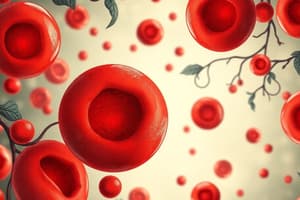Podcast
Questions and Answers
What role do monocytes play in initiating an immune response?
What role do monocytes play in initiating an immune response?
- Producing hemoglobin to transport oxygen.
- Regulating body temperature and pH levels.
- Differentiating into macrophages and presenting antigens to T cells. (correct)
- Directly attacking infected cells through cell-mediated immunity.
If a patient has a condition that reduces the functionality of their natural killer (NK) cells, which of the following would they be most susceptible to?
If a patient has a condition that reduces the functionality of their natural killer (NK) cells, which of the following would they be most susceptible to?
- Reduced oxygen transport due to decreased red blood cell production.
- Viral infections and tumor development due to impaired cell-mediated immunity. (correct)
- Allergic reactions due to increased basophil activity.
- Bacterial infections due to impaired phagocytosis.
How does the biconcave shape of red blood cells facilitate their function?
How does the biconcave shape of red blood cells facilitate their function?
- It enhances their ability to produce antibodies.
- It allows them to squeeze through narrow capillaries and maximizes surface area for gas exchange. (correct)
- It increases the rate at which they are engulfed by macrophages.
- It prevents them from binding to oxygen molecules.
Which of the following is NOT a primary function of blood?
Which of the following is NOT a primary function of blood?
Which of the following best describes the primary function of eosinophils?
Which of the following best describes the primary function of eosinophils?
What is the role of thrombopoietin in blood?
What is the role of thrombopoietin in blood?
What immunological challenge can occur when an Rh-negative mother carries an Rh-positive fetus, and how is it typically prevented?
What immunological challenge can occur when an Rh-negative mother carries an Rh-positive fetus, and how is it typically prevented?
Why is it important to match blood types between a donor and recipient before a blood transfusion?
Why is it important to match blood types between a donor and recipient before a blood transfusion?
Which blood type is considered the 'universal recipient' and why?
Which blood type is considered the 'universal recipient' and why?
What is the primary role of capillaries in the circulatory system?
What is the primary role of capillaries in the circulatory system?
The sinoatrial (SA) node is known as the heart's natural pacemaker. Where is it located and what is its function?
The sinoatrial (SA) node is known as the heart's natural pacemaker. Where is it located and what is its function?
Which sequence correctly describes the passage of deoxygenated blood through the pulmonary circulation?
Which sequence correctly describes the passage of deoxygenated blood through the pulmonary circulation?
What is the purpose of the valves within the veins?
What is the purpose of the valves within the veins?
Which heart chamber receives oxygenated blood from the lungs?
Which heart chamber receives oxygenated blood from the lungs?
What is the function of the atrioventricular (AV) node in the heart’s conduction system?
What is the function of the atrioventricular (AV) node in the heart’s conduction system?
Which blood vessel is responsible for carrying deoxygenated blood from the right ventricle to the lungs?
Which blood vessel is responsible for carrying deoxygenated blood from the right ventricle to the lungs?
How do basophils contribute to the inflammatory response in the body?
How do basophils contribute to the inflammatory response in the body?
What is the role of the aorta in systemic circulation?
What is the role of the aorta in systemic circulation?
Flashcards
What is Blood?
What is Blood?
Fluid connective tissue that circulates throughout the body.
What are the main types of blood cells?
What are the main types of blood cells?
Red blood cells, white blood cells, and platelets.
What are Red Blood Cells (Erythrocytes)?
What are Red Blood Cells (Erythrocytes)?
Biconcave discs that transport oxygen and carbon dioxide.
What is Hemoglobin?
What is Hemoglobin?
Signup and view all the flashcards
What is the function of White Blood Cells (Leukocytes)?
What is the function of White Blood Cells (Leukocytes)?
Signup and view all the flashcards
What is the function of Neutrophils?
What is the function of Neutrophils?
Signup and view all the flashcards
What are the types of Lymphocytes?
What are the types of Lymphocytes?
Signup and view all the flashcards
What is the function of B cells?
What is the function of B cells?
Signup and view all the flashcards
Eosinophils
Eosinophils
Signup and view all the flashcards
Basophils
Basophils
Signup and view all the flashcards
Platelets (Thrombocytes)
Platelets (Thrombocytes)
Signup and view all the flashcards
Functions of Blood
Functions of Blood
Signup and view all the flashcards
Blood Groups
Blood Groups
Signup and view all the flashcards
ABO Blood Group System
ABO Blood Group System
Signup and view all the flashcards
Type A Blood
Type A Blood
Signup and view all the flashcards
Type B Blood
Type B Blood
Signup and view all the flashcards
Type AB Blood
Type AB Blood
Signup and view all the flashcards
Type O Blood
Type O Blood
Signup and view all the flashcards
Rh Blood Group System
Rh Blood Group System
Signup and view all the flashcards
Arteries
Arteries
Signup and view all the flashcards
Veins
Veins
Signup and view all the flashcards
Capillaries
Capillaries
Signup and view all the flashcards
Pulmonary Circulation
Pulmonary Circulation
Signup and view all the flashcards
Study Notes
The provided text appears to be identical to the existing notes. No updates are needed as there is no new information.
Studying That Suits You
Use AI to generate personalized quizzes and flashcards to suit your learning preferences.




